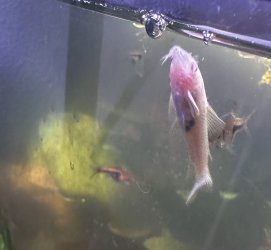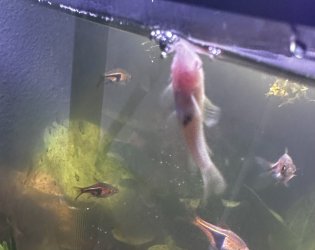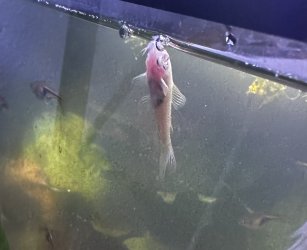I have had my corys for a month, quarantined until 4 days ago, treated with aquarium salt. They were all looking great, eating great, so I added them to my 20 gallon community. All the fish get along great, tank is well cycled, I use purified water to top off, parameters are always 0 for ammonia, nitrite, and nitrate and ph is 6.8. Ok so a couple days ago I noticed one cory swimming very erratically at the top of the tank, and he had a little black mass on his stomach but I assumed he needed to poop so I didn’t worry. Yesterday he started gasping for air and the black mass has gotten bigger so I quarantined him. I really need help figuring out what this is!!
You are using an out of date browser. It may not display this or other websites correctly.
You should upgrade or use an alternative browser.
You should upgrade or use an alternative browser.
Cory cat black stomach
- Thread starter amarieb
- Start date
Corydoras do need to breathe at the surface, so some erratic swimming is normal. They wiggle along the surface when they feel safe.
He's thin, but I see no problem from the photos. He will need to recover from the use of salt, which can be a difficult med for a softwater Corydoras. He is an albino Cory, and the lack of pigment will allow his internal organs to show.
He could well be ill, but. They breathe via gills, which may not have liked the salt, and also through their mouths (exhaling through their butts). This is pure speculation someone else could have better info on, but since the gut is also a breathing apparatus for them, a gut blockage could technically cause distress. I have never encountered that with my own fish, in over 50 years with Corys.
Could it be too warm? Coming out of QT treatment they are extra fragile, and a lot of people over heat their tanks, above the 24 or so that species of Cory likes.
He's thin, but I see no problem from the photos. He will need to recover from the use of salt, which can be a difficult med for a softwater Corydoras. He is an albino Cory, and the lack of pigment will allow his internal organs to show.
He could well be ill, but. They breathe via gills, which may not have liked the salt, and also through their mouths (exhaling through their butts). This is pure speculation someone else could have better info on, but since the gut is also a breathing apparatus for them, a gut blockage could technically cause distress. I have never encountered that with my own fish, in over 50 years with Corys.
Could it be too warm? Coming out of QT treatment they are extra fragile, and a lot of people over heat their tanks, above the 24 or so that species of Cory likes.
Thank you for replying! My tank stays at 78 degrees Fahrenheit. I did do the bare minimum of the salt treatment but maybe that’s it, also he is very small compared to the others who really filled out quickly in the last month. Something is definitely wrong I just can’t for the life of me figure it out.Corydoras do need to breathe at the surface, so some erratic swimming is normal. They wiggle along the surface when they feel safe.
He's thin, but I see no problem from the photos. He will need to recover from the use of salt, which can be a difficult med for a softwater Corydoras. He is an albino Cory, and the lack of pigment will allow his internal organs to show.
He could well be ill, but. They breathe via gills, which may not have liked the salt, and also through their mouths (exhaling through their butts). This is pure speculation someone else could have better info on, but since the gut is also a breathing apparatus for them, a gut blockage could technically cause distress. I have never encountered that with my own fish, in over 50 years with Corys.
Could it be too warm? Coming out of QT treatment they are extra fragile, and a lot of people over heat their tanks, above the 24 or so that species of Cory likes.
Not sure of the circumstances behind the salt treatment but just in case...
IMO the purpose of QT is to watch and observe, only responding if needed. I don't regard this as a treatment period. The fish are already stressed from being moved / shipped, so unless necessary I don't add to the stress by giving them anything other than clean water and food.
IMO the purpose of QT is to watch and observe, only responding if needed. I don't regard this as a treatment period. The fish are already stressed from being moved / shipped, so unless necessary I don't add to the stress by giving them anything other than clean water and food.
I use multiple brands of test strips to test for as many parameters as possible short of buying a chemistry set  I test every 3 days and perform water changes as needed, maybe once a month at 25%.
I test every 3 days and perform water changes as needed, maybe once a month at 25%.
I use purified water because I personally find it easier to start from 0 so I can control what’s going into my tank.
I use purified water because I personally find it easier to start from 0 so I can control what’s going into my tank.
I forgot to mention if anything seems off on the test strips I use API master test kit but I don’t rely on the ammonia one because it has given many false positives many timesI use multiple brands of test strips to test for as many parameters as possible short of buying a chemistry setI test every 3 days and perform water changes as needed, maybe once a month at 25%.
I use purified water because I personally find it easier to start from 0 so I can control what’s going into my tank.
I would suggest doing 25-30% water changes every week, and forgetting about the testing. Use prevention. Once a month is not enough. The water testing 'world' has convinced people that the tests tell you what you need to know, but the cycle and ammonia issues are just one of many aspects of water quality. If you are worried, or enjoy testing, test. But keep regular water changes coming and your fish will thrive.
A water change is almost as quick as pulling out all the testing gear.
The only issue is for people who live with contaminated drinking water that contains nitrates. Usually, that is a rural issue with wells, though some towns have polluted tap.
A water change is almost as quick as pulling out all the testing gear.
The only issue is for people who live with contaminated drinking water that contains nitrates. Usually, that is a rural issue with wells, though some towns have polluted tap.
What other fish do you have? A lot of tropical fish won't thrive in totally pure water (assuming you mean distilled or RO). The usual options are to add minerals or mix it with tap water. I use RO water in all my tanks so do have experience with this.I use multiple brands of test strips to test for as many parameters as possible short of buying a chemistry setI test every 3 days and perform water changes as needed, maybe once a month at 25%.
I use purified water because I personally find it easier to start from 0 so I can control what’s going into my tank.
I also recommend a water change of at least 25% per week, personally I change 75% but if you are lightly stocked 25% should be adequate. It is important that water change means take out water and put in fresh water. Just topping up what is lost due to evaporation means that the concentration of "bad stuff" goes up and the tank can become unhealthy quite quickly. That's the reason I do big changes, every week I remove 75% of the "bad stuff" and the tank stays stable. For an idea of what I mean tip 25% of the water out of a cup of tea (glass of coke if you prefer) and replace with clean water. The tea (or coke) probably won't even change colour.
I appreciate everyone’s concern but this system has been working great for me for quite some time. It is a community tank with a betta, 8 harlequin rasboras, 2 khuli loaches, 3 cory cats, 5 ember tetras, 5 nerite snails, handful of amano shrimp and everyone is thriving. Betta is very active and makes lots of bubble nest. Rasboras shoal unless it’s feeding time then they school, and even exhibit mating behaviors. I never see the khuli loaches but occasionally get a glance of their tails sticking out of the substrate. The other Cory’s are plump and sparkly and constantly foraging. The embers school and and play with each other around the plants mostly. I had an issue with nerite shell weakness but added some cuttlebones and they have been laying eggs all over my tank, literally 100s. The shrimp molt and are out at all hours of the day.
We have gotten off topic though, I’m really concerned about this Cory as it looks so tiny compared to the others and I’m not sure it’s even eating now.
We have gotten off topic though, I’m really concerned about this Cory as it looks so tiny compared to the others and I’m not sure it’s even eating now.
The fish is very red around the gills. That can be from poor water quality or chemicals in the water. Water changes should help if there's something bad in the water.
The black mark is possibly a parasitic worm in the fish. Someitmes fish pick up worm larvae from goats, pigs or other animals and the worm larvae gets lost in the fish. They settle in wherever and grow. Some time later they mature and try to get out of the fish and it goes bad. It could be a worm or something else. If the fish is eating well, just monitor and see what happens.
The black mark is possibly a parasitic worm in the fish. Someitmes fish pick up worm larvae from goats, pigs or other animals and the worm larvae gets lost in the fish. They settle in wherever and grow. Some time later they mature and try to get out of the fish and it goes bad. It could be a worm or something else. If the fish is eating well, just monitor and see what happens.
He had to poopThe fish is very red around the gills. That can be from poor water quality or chemicals in the water. Water changes should help if there's something bad in the water.
The black mark is possibly a parasitic worm in the fish. Someitmes fish pick up worm larvae from goats, pigs or other animals and the worm larvae gets lost in the fish. They settle in wherever and grow. Some time later they mature and try to get out of the fish and it goes bad. It could be a worm or something else. If the fish is eating well, just monitor and see what happens.
You were right, tap water helped his gills improve, the other fish are all great but I’m going to start doing smaller more frequent water changes with tap and occasionally topping off with purified water. I was more concerned with keeping the ph stable but I think I’ll start using some crushed coral or a Seachem buffer to help with that. Any suggestions on which one or some other method I could try?What other fish do you have? A lot of tropical fish won't thrive in totally pure water (assuming you mean distilled or RO). The usual options are to add minerals or mix it with tap water. I use RO water in all my tanks so do have experience with this.
I also recommend a water change of at least 25% per week, personally I change 75% but if you are lightly stocked 25% should be adequate. It is important that water change means take out water and put in fresh water. Just topping up what is lost due to evaporation means that the concentration of "bad stuff" goes up and the tank can become unhealthy quite quickly. That's the reason I do big changes, every week I remove 75% of the "bad stuff" and the tank stays stable. For an idea of what I mean tip 25% of the water out of a cup of tea (glass of coke if you prefer) and replace with clean water. The tea (or coke) probably won't even change colour.
I have very soft water, and it causes no issues. There's no need for additives as long as I stay on the water changes, choose softwater fish and don't overfeed. The nerites aren't a great fit, but all the others will do fine at a pH below 7.
Regular water changes achieve that. One of the reasons I do large changes is that my water has 0KH which means no pH bufferI was more concerned with keeping the ph stable
Similar threads
- Replies
- 1
- Views
- 156
- Replies
- 11
- Views
- 179
- Replies
- 5
- Views
- 435




